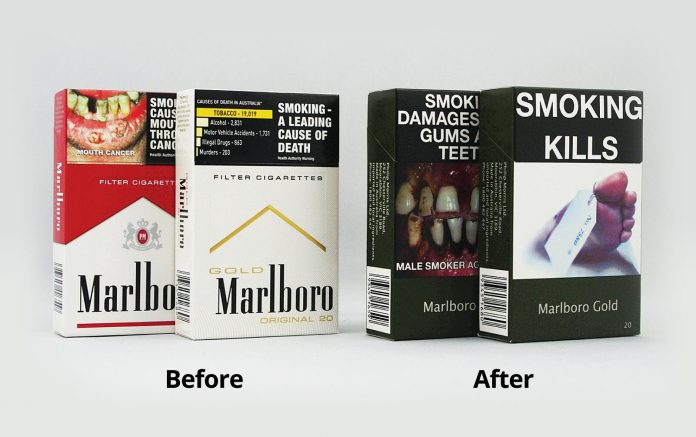Posted: February 2017
By Kenneth Michael Cummings, PhD, MPH
Cigarette packaging designs with different logos, imagery, size configurations and color schemes have been an important marketing tool used by manufacturers to attract different groups to try specific cigarette brands and sub-brands. For example, slim and elegant packaging with feminine imagery is used to attract young female smokers to a particular brand. Lighter-colored packs are often used to convey that a brand is less strong and, by analogy, less harmful, which is attractive to smokers concerned about how smoking might affect their health. Recently, the World Health Organization called on countries everywhere to step up efforts to limit cigarette advertising by introducing plain packaging. The recent WHO report on plain packaging can be found at: http://www.tobaccolabels.ca/wp/wp-content/uploads/2016/06/WHO-2016-Plainpackaging- of-tobacco-products-evidence-design-and-implementation-World-Health- Organization.pdf.
Governments have attempted to counteract the impact of cigarette marketing through a number of actions, including banning certain forms of cigarette promotions such as broadcast marketing, forbidding the distribution of free samples, and requiring health warnings on cigarette packs. In 2001, Canada became the first country to require pictorial warnings on cigarette packs in lieu of less impactful test-only warnings. By 2014, 77 countries and territories had adopted pictorial health warnings (http://www. tobaccolabels.ca/healthwarningsinfo/statusreport/).
Plain packaging came next, with Australia introducing the world’s first regulation in 2012. Plain packaging is often called “standardized” packaging. In Australia, the plain packaging regulations restricted cigarette companies in their use of logos, colors, and brand images on packs, and instead required a standard color and plain font. The regulations have also restricted the physical dimensions of cigarette packaging, including minimum pack size, which has effectively prohibited “super slim” packages (see Figure 1).
Why Plain Packaging Rules Makes Sense
Research conducted before and after the Australian plain packaging legislation has demonstrated three primary effects of plain packaging: 1) it reduces the appeal of cigarette smoking, especially among non-smoking youth; 2) it reduces false health beliefs that some brands are less harmful than others; and 3) it enhances the impact of the health warnings already on the package. This evidence is further bolstered by cigarette companies’ own internal market research, which has demonstrated the importance of packaging as a form of marketing, including evidence showing the important role of pack color and design in influencing consumer perceptions and behaviors.
Australia has seen historic declines in smoking since plain packaging was introduced along with new health warnings and a large tax increase. A government-commissioned review of the impact of the packaging changes found that smoking rates fell an additional 0.55 percentage points between December 2012 and September 2015—a drop attributed to the packaging changes only, and not to the other antitobacco policies the country implemented around that time. Moreover, regardless of any short-term impact, the requirement of plain packaging is likely to have a greater long-term impact, as new generations will grow up without the promotional images and messages on cigarette packs that were so common in the past.
What’s Next?
A number of other countries have committed to implementing plain packaging, including the United Kingdom and France in 2017. Several other countries, including Norway, Hungary, Slovenia, Sweden, Finland, Canada, New Zealand, Singapore, Belgium, and South Africa, have also announced that they are considering similar legislation. Not surprisingly, cigarette manufacturers are not too happy about plain packaging and have attempted to block such legislation by threatening costly lawsuits against governments on the grounds that such legislation violates international trade and trademark laws. The Australian legislation has already withstood multiple legal challenges, and a similar lawsuit in the United Kingdom was rejected by the high court of England. A summary of legal cases to date can be found at: http://www.tobaccolabels.ca/plain-packaging/industry-positions/.
Public health researchers are also looking at additional ways to limit the appeal of cigarettes by banning menthol as a flavoring additive, lowering the nicotine content of cigarettes to reduce the abuse liability of smoking, and requiring inserts inside cigarette packages that would remind smokers about the dangers of smoking and the benefits of not smoking, as well as providing information and advice on how to stop smoking.
None of these measures can come soon enough, as cigarette smoking accounts for 80%–90% of all lung cancer deaths worldwide. Cigarette marketing is a massive driver of cigarette use, which is exactly why cigarette companies are willing to shell out billions of dollars every year to persuade people to buy their products. As noted by one cigarette company executive more than 60 years ago, “The rise and fall of every brand of consequence has been traced in detail and their year to year success or failure shown to be the direct result of consumer advertising.“ (A study of Cigarette Advertising made by J.W. Burgard, 1953; https://www.industrydocumentslibrary.ucsf. edu/tobacco/docs/#id=qymm0104)
Kenneth Michael Cummings, PhD, MPH, is co-leader of the Tobacco Research Program at the Hollings Cancer Center, Medical University of South Carolina, US.











